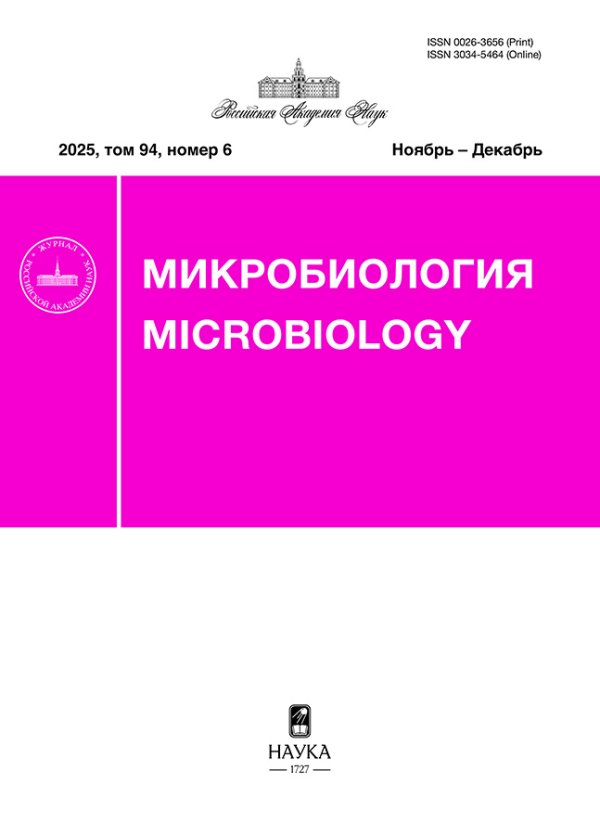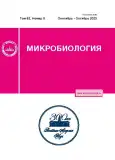Adaptive Properties of Arthrobacter agilis Strain wb28 Isolated from Wheat Bran
- Authors: Sharova N.Y.1, Prichepa A.O.1, Sverdlova O.P.1, Printseva A.A.1
-
Affiliations:
- All‑Russia Research Institute for Food Additives, Branch of Gorbatov Federal Research Center for Food Systems, Russian Academy of Sciences
- Issue: Vol 92, No 5 (2023)
- Pages: 500-509
- Section: EXPERIMENTAL ARTICLES
- URL: https://journals.rcsi.science/0026-3656/article/view/140510
- DOI: https://doi.org/10.31857/S0026365622600766
- EDN: https://elibrary.ru/AMRGHT
- ID: 140510
Cite item
Full Text
Abstract
Abstract
—The article presents the results of a study of some adaptive properties of a bacterial isolate from wheat bran, identified by the 16S rRNA gene as an Arthrobacter agilis strain. According to the literature data, A. agilis does not belong to the dominant bacterial species of wheat microbial associations and activates growth at low ambient temperatures. The studied A. agilis strain showed poor growth in a microbial consortium when an aqueous suspension of wheat bran, partially fermented at 28 ± 1°C by the native microbiota, was plated on a dense MPA medium and produced the pigment after three weeks of storage at 4 ± 1°C. Moderate growth of bacteria without increased pigmentation was observed during its subsequent transfer after low-temperature storage on agar media containing carbohydrates and nitrogen compounds, mineral salts, and vitamins that were more easily utilized than native bran. The growth of colonies upon plating on such media increased in the series: thermally fermented wheat bran → HMF agar → LB (without salt). It was revealed that the A. agilis strain, which was not typical of the wheat bran microflora, under the influence of osmotic and/or temperature shock (in response to a sharp change in the NaCl concentration and/or a difference in ambient temperatures) produced pigments both in agar and liquid cultures. According to the results of spectral analysis, the pigment was assigned to carotenoids and tentatively identified as bacterioruberin. Quantitative evaluation showed that, under stress conditions during submerged cultivation, the studied strain A. agilis wb28 was able to synthesize the pigment at the level of 52.8 mg/L (17.2 mg/g biomass).
About the authors
N. Yu. Sharova
All‑Russia Research Institute for Food Additives, Branch of Gorbatov Federal Research Center for Food Systems,Russian Academy of Sciences
Author for correspondence.
Email: natalya_sharova1@mail.ru
Russia, 191014, St.-Petersburg
A. O. Prichepa
All‑Russia Research Institute for Food Additives, Branch of Gorbatov Federal Research Center for Food Systems,Russian Academy of Sciences
Email: natalya_sharova1@mail.ru
Russia, 191014, St.-Petersburg
O. P. Sverdlova
All‑Russia Research Institute for Food Additives, Branch of Gorbatov Federal Research Center for Food Systems,Russian Academy of Sciences
Email: natalya_sharova1@mail.ru
Russia, 191014, St.-Petersburg
A. A. Printseva
All‑Russia Research Institute for Food Additives, Branch of Gorbatov Federal Research Center for Food Systems,Russian Academy of Sciences
Email: natalya_sharova1@mail.ru
Russia, 191014, St.-Petersburg
References
- Ястребова О.В., Плотникова Е.Г. Галотолерантные бактерии-деструкторы полициклических ароматических углеводородов рода Arthrobacter // Вестн. Пермского ун-та. 2007. Вып. 5. № 10. С. 100‒106.
- Afra S., Makhdoumi A., Matin M.M., Feizy J. A novel red pigment from marine Arthrobacter sp. G20 with specific anticancer activity // J. Appl. Microbiol. 2017. V. 123. P. 1228–1236.
- Bergey’s Manual of Systematics of Archaea and Bacteria / Ed. Whitman W.B. N.Y.: John Wiley & Sons, Inc., 2015. 990 p. ISBN: 978-1-118-96060-8.
- Bertani G. Lysogeny at mid-twentieth century: P1, P2, and other experimental systems // J. Bacteriol. 2004. V. 186. P. 595–600.
- Davidson A., Jaine T. The Oxford Companionto Food. Oxford: Oxford University Press, 2014. 960 p. ISBN 978-0-19-104072-6.
- Flegler A., Lipski A. Engineered CRISPR/Cas9 system for transcriptional gene silencing in Arthrobacter species indicates bacterioruberin is indispensable for growth at low temperatures // Curr. Microbiol. 2022a. V. 79. P. 199.
- Flegler A., Lipski A. The C50 carotenoid bacterioruberin regulates membrane fluidity in pink-pigmented Arthrobacter species // Arch. Microbiol. 2022b. V. 204. P. 70.
- Fong N., Burgess M., Barrow K., Glenn D. Carotenoid accumulation in the psychrotrophic bacterium Arthrobacter agilis in response to thermal and salt stress // Appl. Microbiol. Biotechnol. 2001. V. 56. P. 750–756.
- Hezayen F.F., Tindall B.J., Steinbüchel A., Rehm B.H.A. Characterization of a novel halophilic archaeon, Halobiforma haloterrestris gen. nov., sp. nov., and transfer of Natronobacterium nitratireducens to Halobiforma nitratireducens comb. nov. // Int. J. Syst. Evol. Microbiol. 2002. V. 52. P. 2272–2280.
- Hu Q.-W., Chu X., Xiao M., Li C.-T., Yan Z.-F., Hozzein W.N., Kim C.-J., Zhi X.-Y., Li W.-J. Arthrobacter deserti sp. nov., isolated from a desert soil sample // Int. J. Syst. Evol. Microbiol. 2016. V. 66. P. 2035–2040.
- Jones D., Keddie R.M. The genus Arthrobacter // The Prokaryotes / Eds. Dworkin M., Falkow S., Rosenberg E., Schleifer K.H., Stackebrandt E. New York, N.Y.: Springer, 2006. https://doi.org/10.1007/0-387-30743-5_36
- Kim S., Park H., Choi J. Cloning and characterization of cold-adapted α-amylase from antarctic Arthrobacter agilis // Appl. Biochem. Biotechnol. 2017. V. 181. P. 1048–1059.
- Kumar R., Singh D., Swarnkar M.K., Singh A.K., Kumar S. Complete genome sequence of Arthrobacter alpinus ERGS4:06, a yellow pigmented bacterium tolerant to cold and radiations isolated from Sikkim Himalaya // J. Biotechnol. 2016. V. 220. P. 86–87.
- Margesin R., Schumann P., Sproer C., Gounot A.M. Arthrobacter psychrophenolicus sp. nov., isolated from an alpine ice cave Inter // Int. J. Syst. Evol. Microbiol. 2004. V. 54. P. 2067−2072.
- Nikaido H. The Limitations of LB Medium. Small things considered ‒ The Microbe Blog. ASM. http://schaechter.asmblog.org/schaechter/2009/11/the-limitations-of-lb-medium.html. Архивная копия от 12 ноября 2020 на Wayback Machine.
- Özdal M., Özdal O.G., Gürkök S. Statistical optimization of β-carotene production by Arthrobacter agilis A17 using response surface methodology and Box-Behnken design // II. Int. Conf. on Advances in Natural and Applied Sciences. 18–21 April 2017, Antalya, Turkey / Eds. Akdemir A.O., Ekinci A., Han I., Set E., Dadasoglu F., Karagoz K., Oztekin A. AIP Conference Proceedings, 2017. V. 1833. Iss. 1, id.020101. publ. Apr 25, 2017. ISBN: 978-0-7354-1503-4.
- Özdal M., Özdal O.G., Sezen A., Algur O.F., Kurbanoglu E.B. Continuous production of indole-3-acetic acid by immobilized cells of Arthrobacter agilis // 3 Biotech. 2017. V. 7. Art. 23. P. 1‒6.
- Reddy G.S.N., Prakash J.S.S., Matsumoto G.I., Stackebrandt E., Shivaji S. Arthrobacter roseus sp. nov., a psychrophilic bacterium isolated from an antarctic cyanobacterial mat sample // Int. J. Syst. Evol. Microbiol. 2002. V. 52. P. 1017–1021.
- Sahli K., Gomri M.A., Esclapez J., Gómez-Villegas P., Bonete M.-J., León R., Kharroub K. Characterization and biological activities of carotenoids produced by three haloarchaeal strains isolated from Algerian salt lakes // Arch. Microbiol. 2022. V. 204. P. 6. https://doi.org/10.1007/s00203-021-02611-0
- Saini R.K., Keum Y.S. Microbial platforms to produce commercially vital carotenoids at industrial scale: An updated review of critical issues // J. Ind. Microbiol. Biotechnol. 2019. V. 46. P. 657–674.
- Singh R.N., Gaba S., Yadav A.N., Gaur P., Gulati S., Kaushik R., Saxena A.K. First high-quality draft genome sequence of a plant growth promoting and cold active enzyme producing psychrotrophic Arthrobacter agilis strain L77 // Stand. Genom. Sci. 2016. V. 1. P. 1–9.
- Tamura K., Peterson D., Peterson N., Stecher G. MEGA5: molecular evolutionary genetics analysis using maximum likelihood, evolutionary distance, and maximum parsimony method // Mol. Biol. Evol. 2011. V. 28. P. 2731‒2739.
- Velázquez-Becerra C., Macías-Rodríguez L.I., López-Bucio J., Flores-Cortez I. The rhizobacterium Arthrobacter agilis produces dimethylhexadecylamine, a compound that inhibits growth of phytopathogenic fungi in vitro // Protoplasma. 2013. V. 1. P. 100‒112.
- Weisburg W.G., Barns S.M., Pelletier D.A., Lane D.J. 16S ribosomal DNA amplification for phylogenetic study // J. Bacteriol. 1991. V. 173. P. 697–703.
- Yang L.-L., Liu H.-C., Liu Q., Xin Y.-H. Arthrobacter che-niae and Arthrobacter frigidicola sp. nov., isolated from a glacier // Int. J. Syst. Evol. Microbiol. 2021. V. 71. P. 005177.
- Ye J.-J., Liu S.-W., Lu Q.-P., Cheema M.T., Abbas M., Sajid I., Huang D.-L., Sun C.-H. Arthrobacter mobilis sp. nov., a novel actinobacterium isolated from Cholistan desert soil // Int. J. Syst. Evol. Microbiol. 2020. V. 70. P. 5445–5452.
- Zalazar L., Pagola P., Miró M.V., Churio M.S., Cerletti M., Martínez C., Iniest-Cuerda M., Soler A.J., Cesari A., De Castro R. Bacterioruberin extracts from a genetically modified hyperpigmented Haloferax volcanii strain: antioxidant activity and bioactive properties on sperm cells // J. Appl. Microbiol. 2018. V. 126. P. 796–810.
- Zhang D.-C., Schumann P., Liu H.-C., Xin Y.-H., Zhou Y.-G., Schinner F., Margesin R. Arthrobacter alpinus sp. nov., a psychrophilic bacterium isolated from alpine soil // Int. J. Syst. Evol. Microbiol. 2010. V. 60. P. 2149–2153.
Supplementary files


















